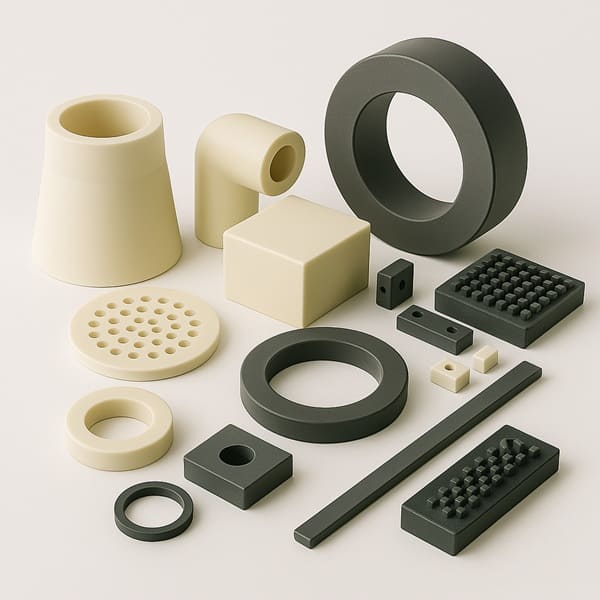How to Choose Materials for the Manufacturing of Ceramics?
Ceramics are a versatile class of materials used in industries ranging from construction to aerospace, medical devices, and everyday household items. Their unique properties, such as high hardness, thermal resistance, and chemical stability, make them indispensable in applications requiring durability and performance under extreme conditions. However, the success of a ceramic product heavily depends on choosing the right materials for its manufacturing. The material selection process is critical, as it directly impacts the product’s performance, cost, and production feasibility.
The goal of this blog post is to provide a comprehensive guide for selecting materials for ceramic manufacturing. Whether you’re a manufacturer, engineer, or designer, understanding how to choose the right materials can help you create high-quality ceramics tailored to specific needs. This article will walk you through the types of ceramic materials, key factors to consider, and a step-by-step process to ensure optimal material selection.
At Advanced Ceramics Hub, we specialize in high-quality advanced ceramic products with various materials and specifications, ensuring optimal performance for industrial and scientific applications.

Understanding Ceramic Materials
Ceramics are inorganic, non-metallic materials typically formed by heating and cooling a mixture of raw materials, such as clay, oxides, or carbides. They are broadly categorized into two types: traditional ceramics (e.g., pottery, tiles, and bricks) and advanced ceramics (e.g., used in electronics, aerospace, and biomedical applications). Each type has distinct characteristics, making material selection a pivotal decision in the manufacturing process.
Common raw materials for ceramics include:
- Clay: Used in traditional ceramics for its plasticity and ability to form shapes when wet.
- Silica (SiO₂): Provides structural stability and is a key component in glass and porcelain.
- Alumina (Al₂O₃): Known for its high strength and thermal resistance, used in advanced ceramics.
- Zirconia (ZrO₂): Offers exceptional toughness and wear resistance, ideal for medical and industrial applications.
- Silicon Carbide (SiC): A non-oxide ceramic valued for its hardness and thermal conductivity.
Ceramics possess unique properties that make them suitable for specific applications:
- Hardness: Resistant to wear and abrasion, ideal for cutting tools.
- Thermal Resistance: Can withstand high temperatures, used in furnace linings and aerospace components.
- Chemical Stability: Resistant to corrosion, making them suitable for chemical processing equipment.
- Electrical Insulation: Used in electronic components like insulators and capacitors.
Looking for high-quality advanced ceramics materials? Explore Advanced Ceramics Hub’s selection.
Factors to Consider in Material Selection for the Manufacturing of Ceramics
Selecting the right material for ceramic manufacturing involves evaluating several factors to ensure the final product meets performance, cost, and production requirements. These factors can be broken down into four main categories:
Application Requirements
The intended application of the ceramic product dictates the material choice. For example, ceramics used in aerospace must withstand extreme temperatures and mechanical stress, while those in medical implants require biocompatibility. Consider the following:
| Factor | Considerations |
| Mechanical Strength | Does the application require high tensile or compressive strength? |
| Thermal Conductivity | Is heat dissipation or insulation critical? |
| Regulatory Compliance | FDA approval for medical ceramics, RoHS for electronics |
Material Properties
✅ Physical Properties
Density and porosity affect weight and strength. Low-porosity ceramics are ideal for applications requiring impermeability.
| Property | Description | Example Material |
| Density | Affects weight and structural integrity | Alumina (high density) |
| Porosity | Impacts permeability and strength | Silica (variable porosity) |
✅ Mechanical Properties
| Factor | Considerations for Ceramics | Example Applications |
| Hardness | High wear resistance, but brittle | Cutting tools, abrasives |
| Strength | High compressive strength, low tensile strength | Structural components |
| Fracture Toughness | Low (prone to cracking) – toughened ceramics (e.g., ZrO₂) improve this | Armor, biomedical implants |
| Elastic Modulus | High stiffness (resists deformation) | Precision instruments |
✅ Thermal Properties
| Factor | Considerations for Ceramics | Example Applications |
| Melting Point | Extremely high (refractory ceramics) | Furnace linings, aerospace |
| Thermal Conductivity | Low (insulators) or high (e.g., AlN for electronics) | Heat sinks, thermal barriers |
| Thermal Shock Resistance | Poor for most ceramics (except SiC, ZrO₂) | Rocket nozzles, kiln furniture |
✅ Electrical & Magnetic Properties
| Factor | Considerations for Ceramics | Example Applications |
| Electrical Conductivity | Usually insulators (Al₂O₃), but some are semiconductors (SiC) | Insulators, electronic substrates |
| Dielectric Properties | High dielectric strength (BaTiO₃ for capacitors) | Capacitors, sensors |
| Piezoelectricity | Converts mechanical to electrical energy (PZT) | Ultrasonic transducers |
✅ Chemical & Environmental Resistance
| Factor | Considerations for Ceramics | Example Applications |
| Corrosion Resistance | Excellent in harsh environments (acids, bases) | Chemical reactors, biomedical implants |
| Oxidation Resistance | Stable at high temperatures (Si₃N₄, Al₂O₃) | Jet engine components |
| Biocompatibility | Non-toxic, inert (e.g., ZrO₂, hydroxyapatite) | Dental/medical implants |
✅ Cost and Availability
Budget constraints and material availability are practical considerations. High-performance materials like zirconia are expensive and may have limited suppliers, while clay is abundant and cost-effective. Evaluate:
- Material Cost: Compare raw material prices and their impact on the final product.
- Supply Chain: Ensure consistent availability to avoid production delays.
- Sustainability: Consider eco-friendly materials to align with environmental goals.
Processing Compatibility
The material must be compatible with the manufacturing process, such as molding, extrusion, or sintering. For example:
- Formability: Clay is easy to mold, while advanced ceramics like silicon carbide may require specialized techniques.
- Firing Temperature: Some materials require high-temperature kilns, increasing energy costs.
- Shrinkage: Materials with high shrinkage during firing may need precise control to maintain dimensions.
Explore our optimized ceramic material products.
Types of Ceramic Materials and Their Uses
Types of Ceramics
Ceramics can be broadly classified into three categories:
A. Traditional Ceramics
Made from naturally occurring raw materials (clay, silica, feldspar).
Examples:
- Earthenware, stoneware, porcelain (pottery, tiles, tableware).
- Refractory ceramics (bricks for kilns, furnaces).
- Cement & concrete (construction materials).
B. Advanced (Engineering) Ceramics
Synthesized from highly pure or chemically modified powders.
Examples:
- Oxides (Alumina/Al₂O₃, Zirconia/ZrO₂ – used in implants, cutting tools).
- Non-oxides (Silicon carbide/SiC, Boron nitride/BN – for abrasives, armor).
- Piezoelectrics (Lead zirconate titanate/PZT – sensors, actuators).
C. Glass Ceramics
- Partially crystallized glasses (e.g., lithium aluminosilicate used in cooktops, telescope mirrors).
Common Applications
| Category | Subtypes | Composition | Examples | Applications |
| Traditional Ceramics | Clay-based | Clay, silica, feldspar | Earthenware, stoneware, porcelain | Tableware, tiles, pottery |
| Refractories | Alumina, silica, fireclay | Firebricks, kiln linings | Furnaces, high-temperature insulation | |
| Cement & Concrete | Calcium silicates, aggregates | Portland cement, concrete | Construction, infrastructure | |
| Advanced (Engineering) Ceramics | Oxide Ceramics | Al₂O₃ (Alumina), ZrO₂ (Zirconia) | Cutting tools, biomedical implants | Engine components, dental crowns |
| Non-Oxide Ceramics | SiC (Silicon Carbide), BN (Boron Nitride) | Armor plates, abrasives | Aerospace, military, grinding wheels | |
| Piezoelectrics | PZT (Lead Zirconate Titanate) | Sensors, actuators | Ultrasound devices, precision motors | |
| Glass Ceramics | Crystalline Glass | Li₂O-Al₂O₃-SiO₂ (Lithium Aluminosilicate) | Cooktops, telescope mirrors | Heat-resistant cookware, optics |
Request a custom quote for high-quality ceramic material products.
Steps to Choose the Right Materials for the Manufacturing of Ceramics
1. Define Application Requirements
Key Questions to Ask:
✔ Mechanical Needs: Load-bearing capacity? Wear resistance?
✔ Thermal Limits: Operating temperature? Thermal cycling?
✔ Chemical Exposure: Corrosion resistance? Biocompatibility?
✔ Electrical Properties: Insulation or conductivity?
✔ Aesthetics & Finish: Color, texture, or surface quality needed?
Example:
For a hip implant, requirements include:
- High strength & fracture toughness (mechanical)
- Biocompatibility (chemical)
- Wear resistance (durability)
→ Suitable Material: Zirconia (ZrO₂) or Alumina (Al₂O₃)
2. Compare Material Properties
Use material property charts or databases (e.g., CES EduPack, MatWeb) to compare candidates.
| Property | Alumina (Al₂O₃) | Zirconia (ZrO₂) | Silicon Carbide (SiC) |
| Hardness (HV) | 1,500-1,800 | 1,200-1,400 | 2,500-3,000 |
| Fracture Toughness (MPa√m) | 3-4 | 6-10 | 3-4 |
| Max Use Temp (°C) | 1,600 | 1,400 | 1,650 |
| Cost | $$ | $$$ | $$$$ |
3. Evaluate Manufacturing Feasibility
Consider:
✔ Formability: Can it be molded, machined, or 3D printed?
✔ Sintering Requirements: High-temperature furnaces needed?
✔ Post-Processing: Grinding, polishing, or coating required?
Example:
- Alumina is easier to machine than SiC but requires high sintering temperatures (~1,600°C).
- Zirconia needs HIP (Hot Isostatic Pressing) for full density.
4. Assess Cost & Availability
Factors:
✔ Raw Material Cost (e.g., SiC is more expensive than Al₂O₃)
✔ Processing Costs (e.g., HIP vs. conventional sintering)
✔ Lead Time & Supply Chain (availability of high-purity powders)
Cost Comparison:
| Material | Powder Cost ($/kg) | Processing Cost | Total Part Cost |
| Alumina | 10-20 | Medium | $$ |
| Zirconia | 50-100 | High (HIP) | $$$ |
| Silicon Carbide | 80-150 | Very High | $$$$ |
5. Consider Sustainability & Regulations
Check:
✔ Recyclability (Can waste material be reused?)
✔ Environmental Impact (Energy-intensive sintering?)
✔ Industry Standards (ISO, ASTM, FDA for medical use)
Example:
- Alumina is more recyclable than SiC.
- Zirconia must meet ISO 13356 for biomedical implants.
At Advanced Ceramics Hub, we supply optimized-grade ceramic products that comply with ASTM and ISO standards, ensuring outstanding quality and reliability.
Choosing the right materials for ceramic manufacturing is a multifaceted process that requires careful consideration of application needs, material properties, cost, and processing compatibility. By following a structured approach—defining requirements, evaluating materials, and testing prototypes—manufacturers can ensure high-quality ceramics that meet performance expectations. Consulting with material scientists or conducting trials can further optimize the selection process, leading to innovative and reliable ceramic products.
For top-quality advanced ceramic materials, Advanced Ceramics Hub provides tailored solutions for various applications.
Looking for premium, advanced ceramic materials? Contact us today!
